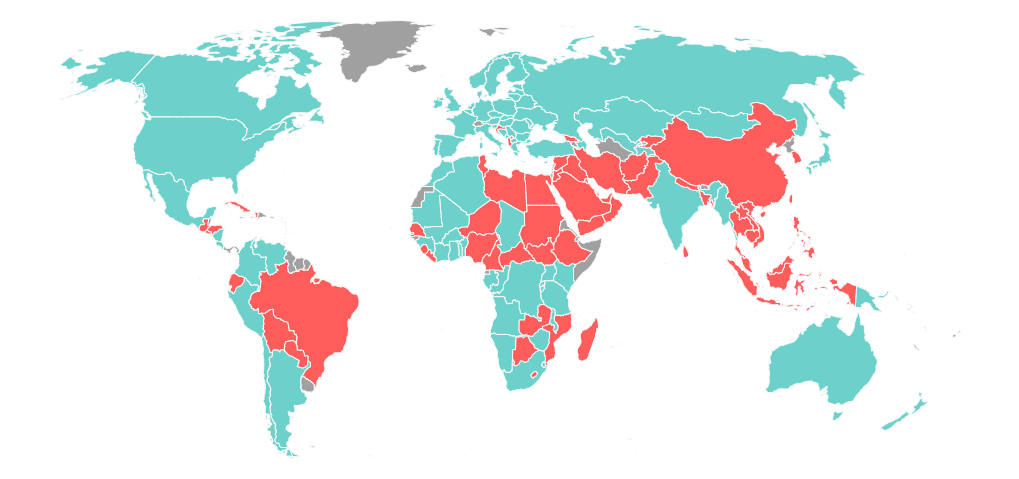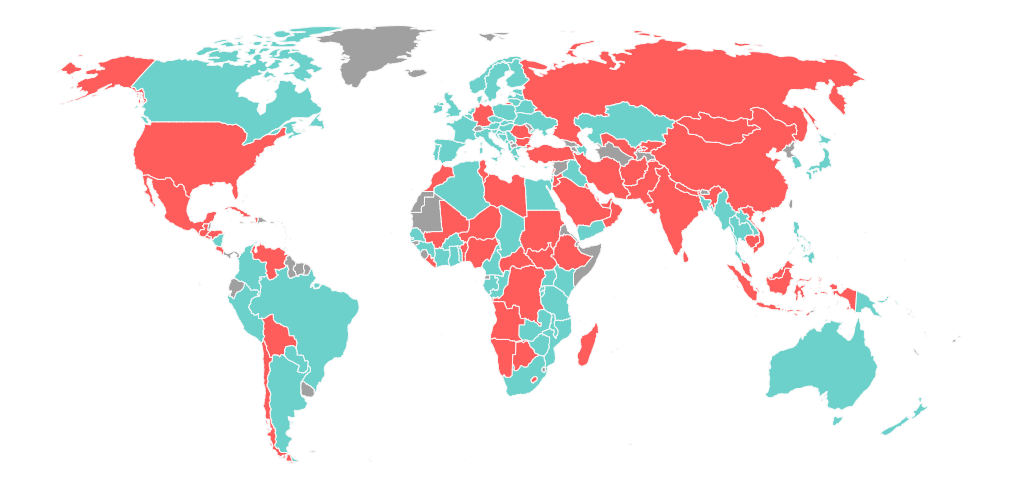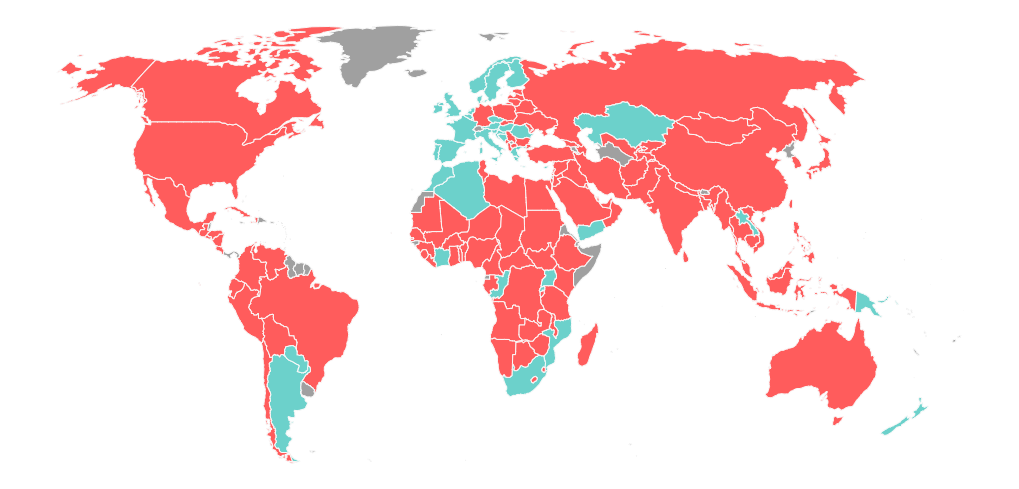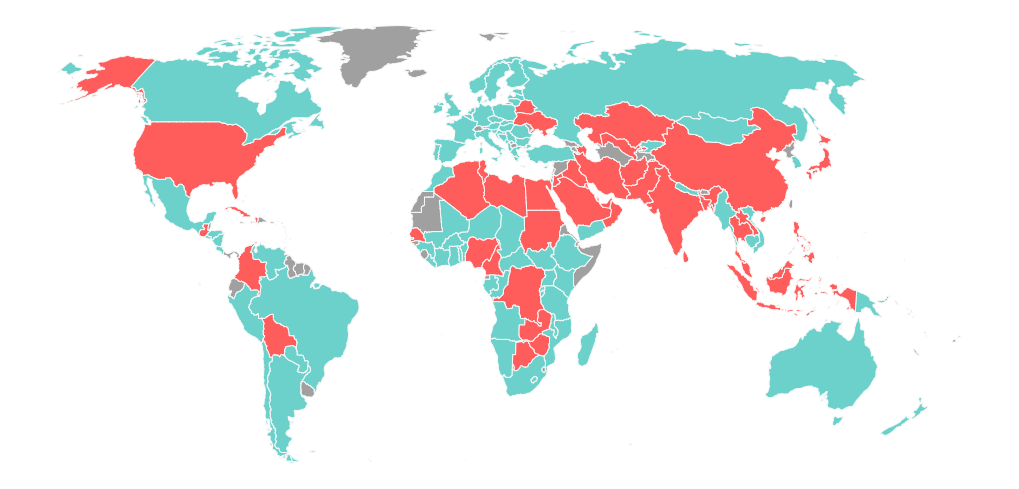The Freedom of Association indicator under the Labour Rights Index measures legislation regulating freedom of association, the right to collective bargaining, and the right to strike.
The indicator also measures whether the law prohibits employers from replacing workers on a legal strike.
About the Freedom of Association Indicator Database
The Freedom of Association indicator under the Labour Rights Index is based on coding the findings of selected four sources (National Legislation, ILO CEACR reports, ITUC Global Rights Index, and USDOS country reports on human rights practices) and compiling this information in a readily accessible and concise manner. The database is designed to be used both by practitioners and researchers. The country profiles provide detailed and verifiable information that can be traced back to the original textual source.
Please reference the Freedom of Association indicator database as follows:
WageIndicator Foundation and Centre for Labour Research. (Year of download XX). Freedom of Association Database. Retrieved from https://clr.org.pk/tudb-2024/ (Date accessed: XXX.)
1. Freedom of Association
2. Collective Bargaining
3. Right to Strike
4. Sanctions against Striking Workers
Freedom of Association
Does the law allow workers to form and join unions of their own choice?
International Regulatory Standard
- Freedom of Association and Protection of the Right to Organise Convention, 1948 (No. 87)
Article 2 of the ILO’s Freedom of Association and Protection of the Right to Organise Convention, 1948 (No. 87) states that workers and employers, without distinction whatsoever, shall have the right to establish and, subject only to the rules of the organisation concerned, to join organisations of their own choosing without previous authorisation.
Scoring Methodology
Whether the law allows Freedom of Association (FoA):
1: The legislation allows workers to form and join organisations of their own choice, except for armed forces and police.
0: There is an explicit general prohibition in law on the right to establish and join organisations, or the law prohibits the establishment of more than one trade union in a single enterprise, or there is a state monopoly through the imposition of a single organisation to which workers and their representative organisations must belong.
Workers are excluded from the right to form and join organisations of their own choice based on exclusionary criteria like race, political opinion, nationality, age or on the grounds of occupational categories (public or private sector) or type of employment (part-time or full-time work; workers are prohibited from joining more than one trade union even if they are engaged in work at different workplaces as part-time workers).
The legislation places excessive requirements on the right to organise in an enterprise by setting a minimum number of workers in an enterprise for registration of a trade union (a minimum of 30 workers in a workplace to allow the establishment of trade unions). Restriction could also take the form of requiring a minimum number of workers to be trade union members (more than 20 members) or setting a high percentage of workers in a workplace to be trade union members (more than 10% of the total workers).*
* These must be considered jointly. The permissible registration requirement for a trade union could be that its members are “at least ten percent (10%) of the total workers employed in the workplace or twenty (20) workers engaged in such workplace, whichever is less”.

Access to Freedom of Association
No Access to Freedom of Association
Collective Bargaining
Does the law allow workers to bargain collectively with employers through their representative unions?
International Regulatory Standard
- Right to Organise and Collective Bargaining Convention, 1949 (No. 98)
Article 4 of the ILO’s Right to Organise and Collective Bargaining Convention, 1949 (No. 98) states that measures appropriate to national conditions shall be taken, where necessary, to encourage and promote the full development and utilisation of machinery for voluntary negotiation between employers or employers’ organisations and workers’ organisations, with a view to the regulation of terms and conditions of employment by means of collective agreements.
Scoring Methodology
Whether the law allows workers to bargain collectively:
1: The legislation allows workers* and their representative organisations to negotiate and conclude collective agreements with employers to determine terms and conditions of employment.
0: There is an explicit general prohibition in the law on the right to collective bargaining. Workers are excluded from the right to bargain collectively based on exclusionary criteria like race, political opinion, nationality or on the grounds of occupational categories (public or private sector) except the public servants engaged in the administration of the state (civil servants employed in government ministries and other comparable bodies). There is an absence of objective, pre-established and precise criteria for determining and recognising trade unions entitled to collective bargaining. There are excessively high representation thresholds (higher than 20%) for trade unions to engage in collective bargaining at the workplace level.
* except armed force, police and public servants engaged in the administration of state

Access to Collective Bargaining
No Access to Collective Bargaining
Right to Strike
Does the law provide the right to strike?
International Regulatory Standard
- Freedom of Association and Protection of the Right to Organise Convention, 1948 (No. 87)
Article 11 of the ILO’s Freedom of Association and Protection of the Right to Organise Convention, 1948 (No. 87) states that each Member of the International Labour Organisation for which this Convention is in force undertakes to take all necessary and appropriate measures to ensure that workers and employers may exercise freely the right to organise.
Para 751 of the Compilation of Decisions of the Committee on Freedom of Association, 2018 shares that while the Committee has always regarded the right to strike as constituting a fundamental right of workers and of their organisations, it has regarded it as such only in so far as it is utilised as a means of defending their economic interests. Para 754 further states that the right to strike is an intrinsic corollary to the right to organise protected by the ILO Convention No. 87.
Scoring Methodology
Whether the law allows the right to strike:
1: The legislation guarantees workers the right to strike.
0: The right to strike is not provided in law or if there is an explicit general prohibition on strikes. There are excessive exclusions based on race, political opinion, nationality, or occupational categories (public or private sector). The right is jeopardised through many restrictions (e.g., limiting or stipulating the duration of a strike before initiation of strike action or where the list of essential services is broader than the approved list).* The right to strike is restricted by imposing a requirement that more than 50% of workers should be in favour of a strike (the requirement of an absolute majority).
The legislation sets too long a period for previous negotiation, conciliation, and mediation (greater than 30 days) or unreasonable notice/cooling-off periods before calling a strike (greater than 14 days). The legislation allows either party (employer or worker organisations) or the government to refer a collective labour dispute to the arbitrator or labour court if parties do not reach an agreement on a collective bargaining agreement or to end a strike (compulsory arbitration). Recourse to compulsory arbitration is, however, allowed if both parties agree to it, or the Government could refer a dispute to the Labour Court for compulsory arbitration in the event of an acute national crisis.
* The score will, however, remain 1 in cases where the list of essential services is broader though the right to industrial action is not restricted and only a minimum service requirement is imposed.

Access to Right to Strike
No Access to Right to Strike
Sanctions against Striking Workers
Does the law prohibit imposing excessive sanctions against striking workers, including replacement of such workers?
International Regulatory Standard
- Right to Organise and Collective Bargaining Convention, 1949 (No. 98)
Article 1 of the ILO’s Right to Organise and Collective Bargaining Convention, 1949 (No. 98) states that workers shall enjoy adequate protection against anti-union discrimination in their employment.
This protection specifically applies to actions that require a worker to either refrain from joining a union or relinquish their union membership as a condition of employment. It also safeguards against dismissal or any other form of prejudice due to a worker’s union membership or participation in union activities, whether outside working hours or, with the consent of the employer, within working hours.
Scoring Methodology
Whether the law prohibits replacing workers on strike:
1: The legislation prohibits imposing excessive sanctions against striking workers, including the replacement of such workers.
0: The law does not prohibit the dismissal or replacement of workers who are on legitimate and peaceful strikes, and excessive sanctions, including monetary fines and imprisonment, are imposed in case of strikes.
There are excessive, disproportionate and/or penal sanctions (monetary fines and imprisonment) for organising or participating in a legitimate strike, regardless of whether the strike is lawful or unlawful under national legislation.
